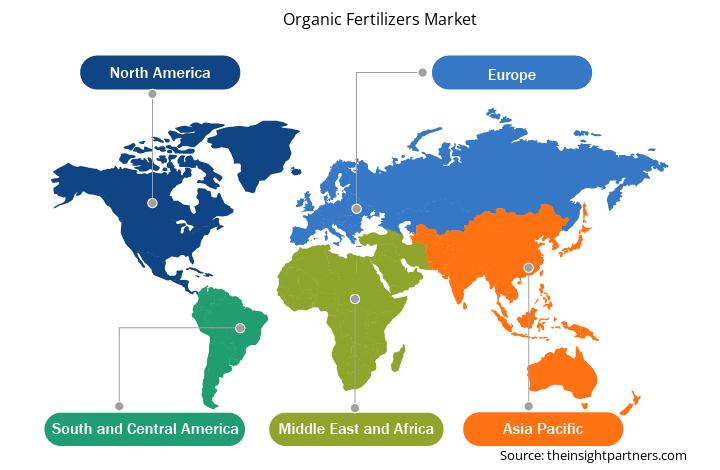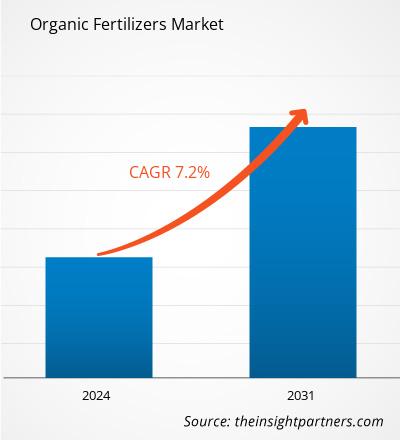من المتوقع أن يصل حجم سوق الأسمدة العضوية إلى 19.40 مليار دولار أمريكي بحلول عام 2031، مقارنةً بـ 11.95 مليار دولار أمريكي في عام 2024. ومن المتوقع أن يسجل السوق معدل نمو سنوي مركب قدره 7.2% خلال الفترة 2024-2031. ومن المتوقع أن يُحدث اعتماد الزراعة الدقيقة اتجاهات نمو جديدة في سوق الأسمدة العضوية، من خلال خلق فرص عمل محتملة خلال الفترة المتوقعة.
تحليل سوق الأسمدة العضوية
مع تحلل المواد العضوية، تُطلق العناصر الغذائية تدريجيًا، مما يوفر إمدادًا بطيئًا ولكنه ثابت من التغذية للنباتات. وهذا يتناقض مع الأسمدة الصناعية، التي غالبًا ما تُوفر العناصر الغذائية بسرعة، ولكنها قد تؤدي إلى اختلال توازن العناصر الغذائية، وتحمض التربة، ونضوب المواد العضوية فيها على المدى الطويل. علاوة على ذلك، تزيد الأسمدة العضوية من النشاط الميكروبي في التربة، مما يُعزز نظامًا بيئيًا متنوعًا ومتوازنًا يدعم دورة العناصر الغذائية، وصحة النبات، ومقاومة الآفات والأمراض. على الرغم من فوائد الأسمدة العضوية الكبيرة، إلا أن لها بعض القيود. فهي عادةً ما توفر تركيزات أقل من العناصر الغذائية مقارنةً بالأسمدة الصناعية، مما يعني الحاجة إلى كميات أكبر لتحقيق نفس النتائج. قد يختلف محتوى العناصر الغذائية في الأسمدة العضوية باختلاف المصدر وطريقة المعالجة، مما يُصعّب التنبؤ بمحتوى العناصر الغذائية بدقة. على الرغم من هذه التحديات، تزداد شعبية الأسمدة العضوية، لا سيما بين البستانيين والمزارعين العضويين والعاملين في مجال الزراعة المستدامة. يمكن للمزارعين والبستانيين تقليل تأثيرهم البيئي باستخدام الأسمدة العضوية، ودعم التنوع البيولوجي، وإنشاء أنظمة بيئية أكثر صحة ومرونة. بشكل عام، تعتبر الأسمدة العضوية ضرورية للحفاظ على خصوبة التربة على المدى الطويل وتعزيز صحة النباتات والبيئة.
نظرة عامة على سوق الأسمدة العضوية
تُشتق الأسمدة العضوية طبيعيًا من مصادر نباتية وحيوانية ومعدنية، وهي تُوفر العناصر الغذائية الأساسية للنباتات. تُحسّن الأسمدة العضوية خصوبة التربة وتعزز الممارسات الزراعية المستدامة من خلال تعزيز بنيتها ودعم الكائنات الحية الدقيقة النافعة. تُعتبر هذه الأسمدة صديقة للبيئة بشكل عام، إذ إنها قابلة للتحلل الحيوي وتقلل من خطر تلوث المياه وتدهور التربة. الأسمدة العضوية غنية بالعناصر الغذائية الكبرى (النيتروجين والفوسفور والبوتاسيوم، إلخ) والعناصر الغذائية الدقيقة (الكالسيوم والمغنيسيوم والكبريت، إلخ)، وجميعها ضرورية لنمو صحي للنبات. تُشكل الأسمدة الحيوانية أحد أكثر أنواع الأسمدة العضوية شيوعًا؛ وتشمل هذه الأسمدة السماد العضوي المُستخلص من الأبقار والدجاج والخيول. الأسمدة العضوية الحيوانية غنية بالنيتروجين والمواد العضوية، مما يُحسّن قوام التربة واحتباس الماء والنشاط الميكروبي. من ناحية أخرى، تُنتج الأسمدة النباتية من مواد نباتية مثل الأعشاب البحرية أو دقيق البرسيم أو مخلفات المحاصيل المُستخلصة.
قم بتخصيص هذا التقرير ليناسب متطلباتك
ستحصل على تخصيص لأي تقرير - مجانًا - بما في ذلك أجزاء من هذا التقرير، أو تحليل على مستوى الدولة، وحزمة بيانات Excel، بالإضافة إلى الاستفادة من العروض والخصومات الرائعة للشركات الناشئة والجامعات
سوق الأسمدة العضوية: رؤى استراتيجية

- احصل على أهم اتجاهات السوق الرئيسية لهذا التقرير.ستتضمن هذه العينة المجانية تحليل البيانات، بدءًا من اتجاهات السوق وحتى التقديرات والتوقعات.
محركات وفرص سوق الأسمدة العضوية
المبادرات الاستراتيجية لشركات الأسمدة تعزز نمو السوق
تُنفّذ الشركات الرئيسية في سوق الأسمدة عمومًا مبادرات استراتيجية لتوسيع حضورها في السوق، وتعزيز استدامة المحاصيل، وتلبية طلبات المستهلكين المتزايدة. تُركّز هذه المبادرات على تحسينات سلسلة التوريد، والتطورات التكنولوجية، وبرامج الاعتماد، والشراكات، واستثمارات البحث والتطوير. يلعب منتجو الأغذية العضوية، وتجار التجزئة، وشركات الأعمال الزراعية، وغيرهم، دورًا حاسمًا في تشكيل منظومة الزراعة العضوية. تستثمر شركات الأسمدة العضوية في البحوث الزراعية والتكنولوجيا الحيوية لمواجهة التحديات المرتبطة بالزراعة العضوية، بما في ذلك انخفاض الغلة ونمو الآفات. على سبيل المثال، تستكشف شركتا باير إيه جي وسينجينتا، وهما منتجان معروفان للأسمدة الاصطناعية، الأسمدة الصديقة للبيئة وحلول صحة التربة. في مارس 2023، جمعت شركة ويندفول بايو 9 ملايين دولار أمريكي كتمويل أولي لإطلاق حل لتحويل الميثان إلى سماد عضوي. خططت الشركة لتطوير أول حل على الإطلاق لالتقاط انبعاثات الميثان وتحويلها إلى أسمدة عضوية حية.
اللوائح والسياسات الحكومية الداعمة للزراعة العضوية لخلق فرص النمو
تُطبّق الحكومات لوائح وسياسات لتعزيز الزراعة العضوية كجزء من استراتيجياتها الأوسع للاستدامة والأمن الغذائي. تُركّز هذه السياسات على الحوافز المالية، ومعايير الاعتماد، ودعم البحوث للمساعدة في تطوير السوق بشكل عام وتشجيع الانتقال من الزراعة التقليدية إلى الزراعة العضوية. تدعم جميع دول الاتحاد الأوروبي الأعضاء تقريبًا الزراعة العضوية من خلال التعريف القانوني على مستوى الاتحاد الأوروبي، ومدفوعات التحويل والصيانة الزراعية البيئية، ومنح التسويق والمعالجة للتنمية الريفية، ومبادرات تمويل الترويج، والمشتريات العامة، ومبادرات البحث والمعلومات. في عام 2020، أطلقت المفوضية الأوروبية استراتيجية "من المزرعة إلى المائدة"، التي حددت سلسلة من الأهداف لتعزيز الاستدامة في إنتاج الغذاء في الاتحاد الأوروبي. تشمل هذه الأهداف خفض استخدام المبيدات الحشرية بنسبة 50% وخفض استخدام الأسمدة بنسبة 20%؛ كما تهدف إلى زيادة حصة الزراعة العضوية إلى 25% من إجمالي الأراضي الزراعية. في عام 2022، أطلقت وزارة الزراعة الأمريكية مبادرة التحول العضوي باستثمار قدره 300 مليون دولار أمريكي، والتي تُقدّم مجموعة من البرامج والموارد لمساعدة المزارعين العضويين الحاليين وأولئك الذين ينتقلون إلى الإنتاج والمعالجة العضوية في الولايات المتحدة.
تحليل تجزئة تقرير سوق الأسمدة العضوية
إن القطاعات الرئيسية التي ساهمت في اشتقاق تحليل سوق الأسمدة العضوية هي المصدر والشكل ونوع المحصول.
- يُقسّم سوق الأسمدة العضوية، حسب المصدر، إلى نباتات وحيوانات ومعادن. وقد استحوذ قطاع النباتات على الحصة الأكبر من السوق في عام ٢٠٢٤.
- بناءً على الشكل، ينقسم السوق إلى قسمين: جاف وسائل. وسيهيمن قطاع المنتجات الجافة على السوق في عام ٢٠٢٤.
- بناءً على نوع المحصول، يُقسّم السوق إلى: الفواكه والخضراوات، والحبوب، والعشب ونباتات الزينة، والزهور والمشاتل، والمحاصيل الشجرية، والبقوليات، والأعشاب والتوابل، والبذور الزيتية، والدرنات والمحاصيل الجذرية، وغيرها. وقد استحوذ قطاع البذور الزيتية على أكبر حصة سوقية في عام ٢٠٢٤.
تحليل حصة سوق الأسمدة العضوية حسب المنطقة الجغرافية
ينقسم النطاق الجغرافي لتقرير سوق الأسمدة العضوية إلى خمس مناطق: أمريكا الشمالية، وآسيا والمحيط الهادئ، وأوروبا، والشرق الأوسط وأفريقيا، وأمريكا الجنوبية والوسطى. ومن المتوقع أن يشهد سوق الأسمدة العضوية في آسيا والمحيط الهادئ نموًا ملحوظًا خلال فترة التوقعات.
من بين دول آسيا والمحيط الهادئ، تُقدّم أستراليا طلبًا كبيرًا على الأسمدة العضوية، مما يُعزى إلى زيادة مساحة الأراضي الزراعية العضوية. ووفقًا للاتحاد الدولي لحركات الزراعة العضوية (IFOAM)، أصبحت أستراليا الدولة صاحبة أكبر مساحة أراضي زراعية عضوية في العالم، حيث زادت المساحة المُخصّصة للزراعة العضوية بمقدار 17.3 مليون هكتار في عام 2022 مُقارنةً بعام 2021، لتصل إلى 53 مليون هكتار في عام 2022. تُركّز أستراليا على الزراعة المُستدامة، بدعم من السياسات والمبادرات الحكومية. على سبيل المثال، أنشأت الحكومة الأسترالية برنامج الزراعة الذكية مناخيًا في الفترة 2023-2024، والذي يمتد على مدى خمس سنوات باستثمار قدره 185.38 مليون دولار أمريكي. يهدف البرنامج إلى دعم الاستدامة الزراعية والإنتاجية والقدرة التنافسية. وبالتالي، فإن قطاع الزراعة العضوية القوي والمبادرات الحكومية الداعمة تُعزّز نمو سوق الأسمدة العضوية في البلاد.
رؤى إقليمية حول سوق الأسمدة العضوية
قام محللو إنسايت بارتنرز بشرح شامل للاتجاهات الإقليمية والعوامل المؤثرة في سوق الأسمدة العضوية خلال فترة التوقعات. ويناقش هذا القسم أيضًا قطاعات سوق الأسمدة العضوية ومناطقها الجغرافية في أمريكا الشمالية، وأوروبا، وآسيا والمحيط الهادئ، والشرق الأوسط وأفريقيا، وأمريكا الجنوبية والوسطى.

- احصل على البيانات الإقليمية المحددة لسوق الأسمدة العضوية
نطاق تقرير سوق الأسمدة العضوية
| سمة التقرير | تفاصيل |
|---|---|
| حجم السوق في عام 2024 | 11.95 مليار دولار أمريكي |
| حجم السوق بحلول عام 2031 | 19.40 مليار دولار أمريكي |
| معدل النمو السنوي المركب العالمي (2024 - 2031) | 7.2% |
| البيانات التاريخية | 2021-2023 |
| فترة التنبؤ | 2024-2031 |
| القطاعات المغطاة | حسب المصدر
|
| المناطق والدول المغطاة | أمريكا الشمالية
|
| قادة السوق وملفات تعريف الشركات الرئيسية |
|
كثافة اللاعبين في سوق الأسمدة العضوية: فهم تأثيرها على ديناميكيات الأعمال
يشهد سوق الأسمدة العضوية نموًا متسارعًا، مدفوعًا بتزايد طلب المستخدمين النهائيين نتيجةً لعوامل مثل تفضيلات المستهلكين المتطورة، والتقدم التكنولوجي، وزيادة الوعي بفوائد المنتج. ومع تزايد الطلب، تعمل الشركات على توسيع عروضها، والابتكار لتلبية احتياجات المستهلكين، والاستفادة من الاتجاهات الناشئة، مما يُعزز نمو السوق.
تشير كثافة اللاعبين في السوق إلى توزيع الشركات العاملة في سوق أو قطاع معين. وتشير إلى عدد المنافسين (اللاعبين في السوق) الموجودين في سوق معين نسبةً إلى حجمه أو قيمته السوقية الإجمالية.
الشركات الرئيسية العاملة في سوق الأسمدة العضوية هي:
- أجروكير كندا
- شركة بيوستار للطاقة المتجددة ذ.م.م
- شركة كورومانديل الدولية المحدودة
- منتجع إيتالبولينا الصحي
- الزراعة الحيوية في الغرب الأوسط
- كريشاك بهاراتي التعاونية المحدودة
إخلاء المسؤولية : الشركات المذكورة أعلاه ليست مرتبة بأي ترتيب معين.

- احصل على نظرة عامة على أهم اللاعبين الرئيسيين في سوق الأسمدة العضوية
أخبار سوق الأسمدة العضوية والتطورات الأخيرة
يُقيّم سوق الأسمدة العضوية بجمع بيانات نوعية وكمية بعد البحث الأولي والثانوي، والتي تشمل منشورات الشركات المهمة، وبيانات الجمعيات، وقواعد البيانات. وفيما يلي بعض التطورات الرئيسية في سوق الأسمدة العضوية:
- في ديسمبر 2024، أعلنت شركة كورومانديل الدولية المحدودة (الشركة الرائدة في مجال الحلول الزراعية في الهند) وكريش-إي (قطاع المعدات الزراعية التابع لشركة ماهيندرا آند ماهيندرا المحدودة) عن شراكة لتوسيع نطاق خدمات الرش بالطائرات المسيرة التي تقدمها كورومانديل، جرومور درايف، لتشمل المزارعين الهنود. (المصدر: موقع شركة كورومانديل الدولية المحدودة الإلكتروني، ديسمبر 2024)
- استحوذت شركة أندرسونز على حصة الأغلبية في شركة سكاي لاند جرين. تُمكّن هذه الصفقة شركة أندرسونز من توسيع أعمالها الأساسية في مجال الحبوب والأسمدة في أسواق استراتيجية، بما في ذلك كانساس وأوكلاهوما وكولورادو وتكساس. (المصدر: بيان صحفي لشركة أندرسونز، نوفمبر ٢٠٢٤)
تغطية تقرير سوق الأسمدة العضوية والنتائج المتوقعة
يقدم تقرير "حجم سوق الأسمدة العضوية والتوقعات (2021-2031)" تحليلاً مفصلاً للسوق يغطي المجالات التالية:
- حجم سوق الأسمدة العضوية وتوقعاته على المستويات العالمية والإقليمية والوطنية لجميع قطاعات السوق الرئيسية التي يغطيها النطاق
- اتجاهات سوق الأسمدة العضوية، بالإضافة إلى ديناميكيات السوق مثل المحركات والقيود والفرص الرئيسية
- تحليل مفصل لقوى بورتر الخمس ونقاط القوة والضعف والفرص والتهديدات
- تحليل سوق الأسمدة العضوية الذي يغطي اتجاهات السوق الرئيسية والإطار العالمي والإقليمي والجهات الفاعلة الرئيسية واللوائح والتطورات الأخيرة في السوق
- تحليل المشهد الصناعي والمنافسة الذي يغطي تركيز السوق، وتحليل خريطة الحرارة، واللاعبين البارزين، والتطورات الأخيرة في سوق الأسمدة العضوية
- ملفات تعريف الشركة التفصيلية
- التحليل التاريخي (سنتان)، سنة الأساس، التوقعات (7 سنوات) مع معدل النمو السنوي المركب
- تحليل PEST و SWOT
- حجم السوق والقيمة / الحجم - عالمي، إقليمي، بلد
- الصناعة والمنافسة
- مجموعة بيانات إكسل
التقارير الحديثة
تقارير ذات صلة
شهادات العملاء
سبب الشراء
- اتخاذ قرارات مدروسة
- فهم ديناميكيات السوق
- تحليل المنافسة
- رؤى العملاء
- توقعات السوق
- تخفيف المخاطر
- التخطيط الاستراتيجي
- مبررات الاستثمار
- تحديد الأسواق الناشئة
- تحسين استراتيجيات التسويق
- تعزيز الكفاءة التشغيلية
- مواكبة التوجهات التنظيمية




















 احصل على عينة مجانية ل - سوق الأسمدة العضوية
احصل على عينة مجانية ل - سوق الأسمدة العضوية